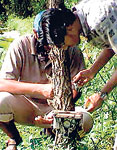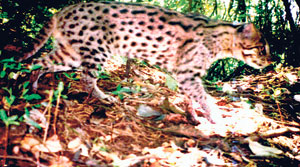Sacheendra Deepankara got the call around 8.30 p.m. on May 13. A friend from Kohuwela phoned to alert him about a mysterious animal that had been hit by a vehicle. An active member of the Young Zoologists’ Association, Deepankara rushed to the site and called the Dehiwala Zoo.
Zoo authorities were quick to send a team and rushed to the car sales centre where the mysterious animal had taken shelter. The torch light caught a pair of glowing eyes under a parked vehicle. With a loud ‘hissing’ noise the animal tried to escape, but the team managed to secure the nets around the ‘cat like’ creature. It had a long, stocky body and relatively short legs with a broad head. Its olive-gray fur coat with black stripes and rows of black spots made it look like a small leopard. Deepankara was quick to identify the well grown animal as a Fishing Cat, known as ‘handun diviya’ in Sinhala.
Fishing cats prefer densely vegetated areas near water - marshes, mangroves, rivers and streams. “I was amazed to see a full grown Fishing Cat in an urban area like Kohuwela,” said Deepankara. Residents said another wild cat that had fallen into a well was rescued by them a few months ago.
“There were two animals that used to roam close to the spot where the fishing cat was hit by the speeding vehicle. But they were harmless and would run away if they sensed a human presence,” said another resident. Deepankara believes the abandoned paddy fields near Green Avenue, Kohuwela could be their home.
The Fishing Cat is a medium-sized wild cat that depends on wetlands. So how can such a wild cat appear in a suburban environment? Dr.Eric Wikremanayake - a senior scientist of the World Wildlife Fund (WWF) - who had studied Fishing Cats in urban environments in Sri Lanka provided some answers. “It is an elusive creature that can survive in the remaining wetlands in Colombo,” says Dr. Wikramanayake. Fishing cats were recorded in areas such as Boralesgamuwa, Nawala where little pockets of forest, marshes, and mangroves remain.
Fishing cats are nocturnal and truly secretive wild cats that avoid humans so studying them is a nightmare for researchers. Dr. Wikramanayake faced the same problem during his study of this urban fishing cat population done in early 2000 at Attidiya/Bellanwila and Sri Jayawardenepura/Kotte wetlands with the approval of Department of Wildlife Conservation (DWC) and funding from the Smithsonian National Zoological Park. The research team first interviewed the villagers and identified the areas fishing cats are frequently seen. Then they used quite an unusual method to study these wild cats, setting camera traps all around the edges of the identified fishing cat routes. The fishing cats took their own pictures by breaking a sensory beam that triggers the camera shutter as they walked past. Pictorial evidence confirmed their presence in Nawala and Attidiya.
 |
| Setting up a camera trap |
This study also shed light on the behaviour and ecology of this wild cat that ironically, lives so close to human habitation. The time recorded on the photographs indicated that fishing cats are active both day and night. Although people reported seeing them very early in the morning, the photographs showed fishing cats walking around at midday. Some shots recorded more than one Fishing Cats. This indicates that mating too is not a problem and the remaining population would survive, if the urban wilderness was retained. “Being a charismatic species, we should use the Fishing Cat as a flagship species to promote the need to protect our remaining wetlands,” says Dr. Wikremanayake.
The research team had plans to radio collar fishing cats to track their movements and distribution.
They also had plans to compare the behaviour patterns of fishing cats in urban areas with fishing cats living in natural environments.
The second part of the study however was halted due to security reasons as the two main sites are located near high security zones – one near the Parliament and the other near Ratmalana airport.
During the initial study, the team found that fishing cats are often accused of preying on chickens. The Fishing Cat research team also began an awareness campaign among the local residents and in schools, to impress upon people that what they have in their backyards is something special—an endangered wild cat that needs to be conserved. The latest victim - the Kohuwala Fishing Cat was already dead by the time it was taken to the Animal Hospital in Dehiwala Zoo. So it needs a collective effort to protect the remaining Fishing Cat population in urban and suburban areas, before it is too late.
Fishing Cat – fact file
Known as the “bull dog” of cats, the fishing cat has a long, stocky body. The average weight of a male is 12 kg while a female weighs around 7 kg. Its diet includes birds, small mammals, snakes, snails, and of course fish.
The cat attracts fish by lightly tapping the water's surface to catch the fish. It can also use its partially webbed paws to scoop fish, frogs, and other prey out of the water or swim underwater to prey on ducks and other aquatic birds.
It is powerful enough to take large prey, such as calves and dogs.
Listed as ‘vulnerable’ on the World Conservation Union's (IUCN) Red List of Threatened Species, fishing cats are threatened by habitat loss and hunting.
|


